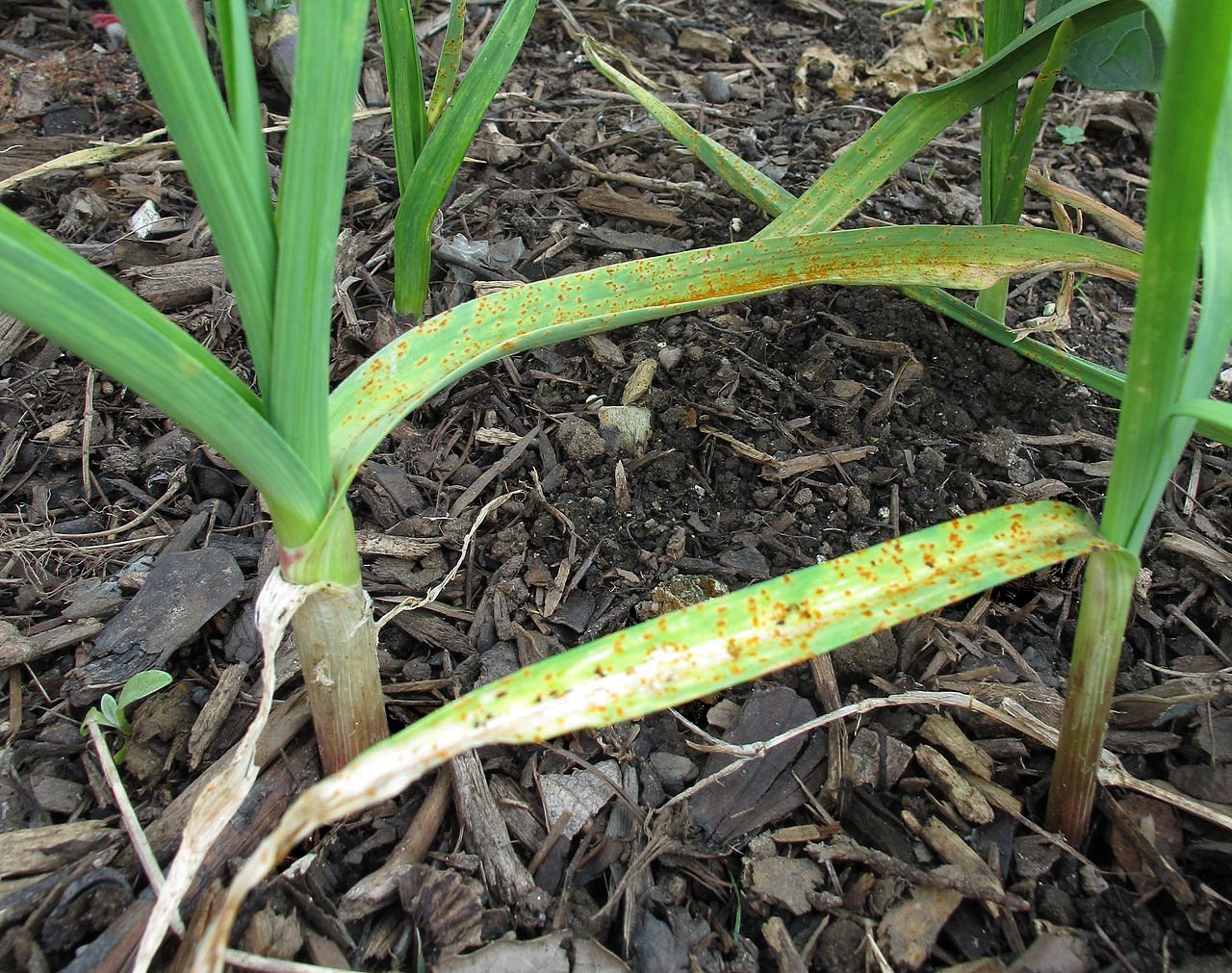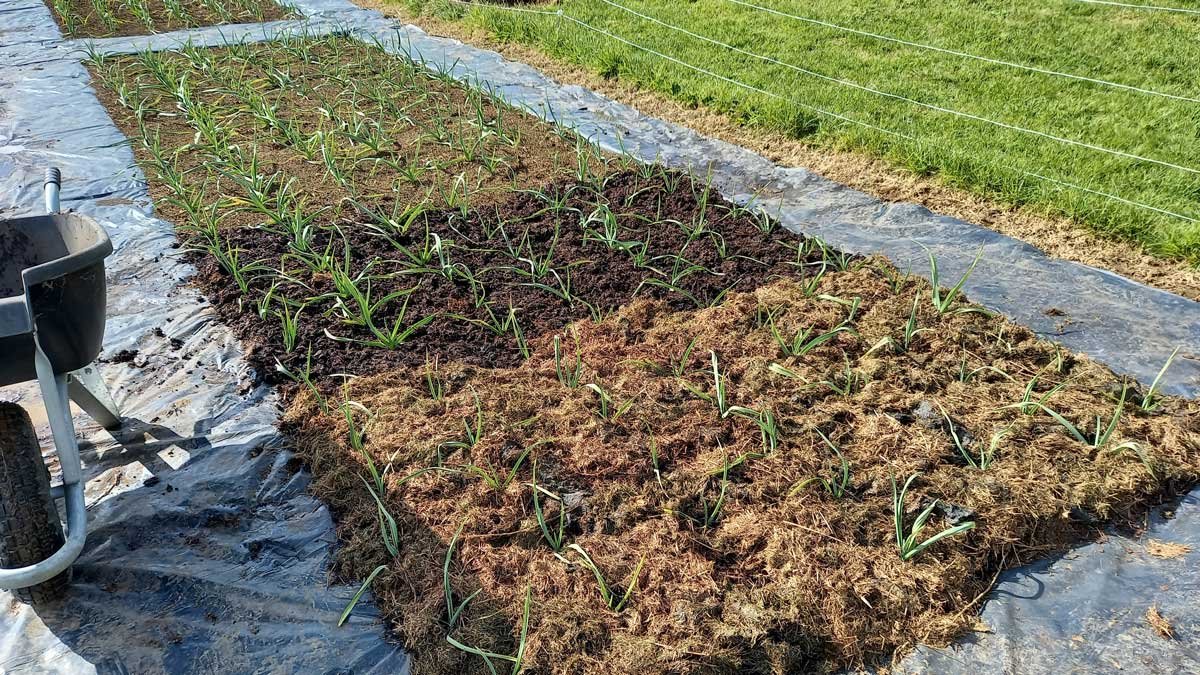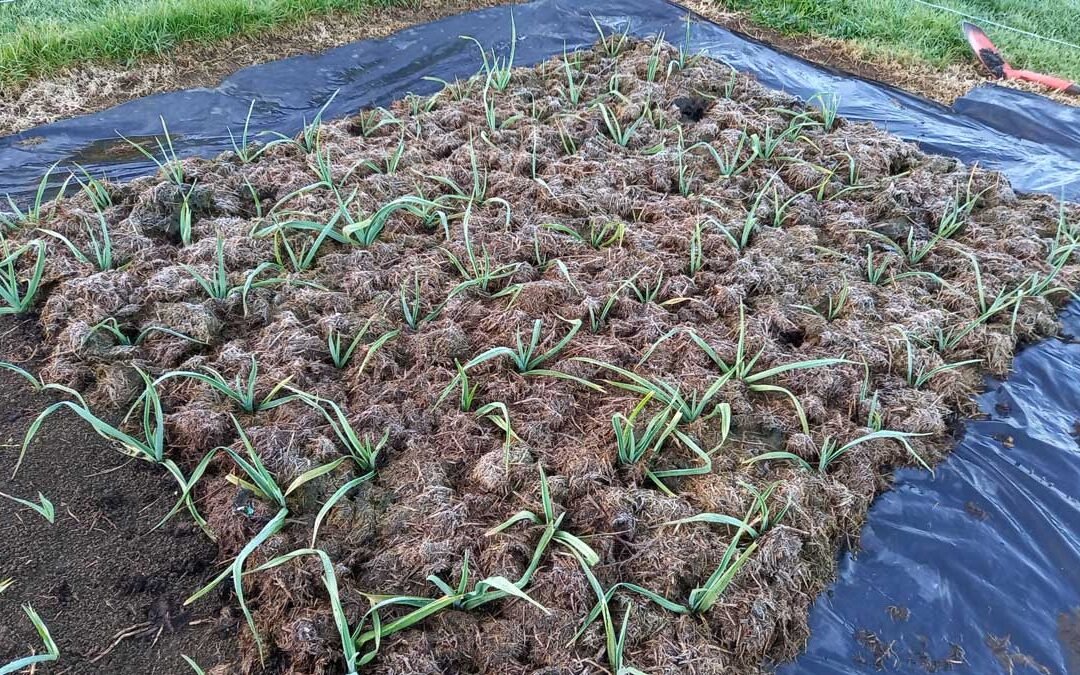This is the second in a series of three blogs about growing garlic. Here’s part one: Everything I know about planting garlic.
So. Your garlic is growing. Hopefully you’ve kept the weeds off. Maybe you’ve found yourself with a bit of rust.
I have 3 garlic patches this year: the main crops, which were planted in May. There’s just under 1000 of them in four beds. Then there’s the experimental crops – new varieties which I am trying out to see if they should join the ‘collection’ next year. Finally, there’s the bed giving retail-sourced Printanor one last try, as well as growing on some bulbil-grown Ajo Roja.
For my main crops, we’re a little over half-way through the season. It’s time to top-up the organic matter and start getting serious about liquid fertilisers.
Weeding
Garlic hates competition. It dislikes humidity. Weeds are not a good thing in a garlic bed – they’re competition that can increase the humidity. If you have weeds in your garlic patch, it’s time to get out there and remove them.
A Wonder Weeder or hoe are perfect for the job (depending on how big your bed is). It’s easiest to get weeds while they’re small – simply dislocate the plant and it’s gone.
I spend up to two hours a week weeding my garlic. I go out there with a hoe and a podcast and wander about, rubbing out the weeds. Obviously if you’re growing a less intense amount of garlic, it won’t take anywhere near as long.

Not my rust – photo is Public Domain courtesey of Downtowngal on Wikimedia.
While you’re weeding, pay close attention to the leaves of your garlic and look for problems. The biggest issue you’re looking for right now is rust. Especially if you’ve planted your garlic quite close together. It looks like little, slightly furry orange dots that begin right at the tips of your leaves.
Spraying
If you happen to find rust, remove the leaves you’ve found it on. Make sure you sterilize your tools and wash your hands, gloves, and clothes when you’re done to avoid spreading it to other parts of the garden.
After the infected leaves have been removed, spray your garlic with copper. Copper is an organic preventative. It can only prevent the spread of rust. Once your garlic has rust, it’s important to stay on top of it to give your plants the best chance of making it through to harvest.
I use Yates Liquid Copper at the rate recommended for onions alongside Yates Sprayfix as a preventative about once a month.
The Sprayfix is basically a soap that helps the copper penetrate (and protect) the garlic. I use it mostly because we don’t get many rain-free days in winter and I want to ensure I get as much benefit before the next cloud rolls over. I haven’t seen signs of rust on my crops at The Outpost to date.
Mulching
Probably my least favourite job, if I’m honest. But it is also super important, so I’ve been hard at work mulching my beds in the last week – and will be working on it for probably another week or two. I use a layer of compost, followed by a layer of grass mulch.
This year, my compost is home-made. I’ll use it until it runs out – I’m a little over half way through the pile. But I’ll probably have to get at least a cubic meter in from the landscape supplies yard for the other beds. I apply a layer a couple of centimeters thick.
The grass mulch is picked up by the mower and then dumped in a big pile to rot down for at least 3 days, but up to 2 weeks. The rotting is important to prevent the kikuyu from re-invading the garden beds. The layer is at least as thick as the compost.

The benefit of mulching is that you will have less weeding from here on out! It’ll also help retain some of this winter moisture for as long as possible into summer.
This bit takes a lot of time when you’re mulching 1000 garlic plants. I do this a lot by hand to avoid getting compost or mulch inside the stem of the plant as much as possible. I’ll probably need to come up with a better method as my production gets bigger, but at least this way I’m paying close attention each and every plant in my crop.
Fertilising
Obviously, the compost and mulch (not to mention all the organic matter we added when we planted in the first place) will be adding nutrients. Garlic is hungry, and it will be turning all that goodness into whatever magic keeps the vampires away.
As our days get longer and the temperature rises, the garlic is about to boost in growth – particularly below the ground. A regular dose of liquid fertiliser during months 4 and 5 of growth will help support bulb growth.
In our garden, we use worm wees from our wormfarm. That’s it. We water it down to a concentration of about 20% worm wees to 80% water. I try and get out there once a week once I get to quit weeding so much.
If you don’t have a wormfarm, then a seaweed and/or fish-based fertiliser is a balanced organic option. They’re made by a range of manufacturers and every store will have a few to choose from. Choose what fits your crop size and budget.
Scapes
If you’re growing a hard-necked garlic, you’ll need to keep your eye out for scapes. I found a hard-necked garlic for sale at Mitre 10 this year, so it’s been more available to home growers this season. In my garden, Russian Red, Spanish Red, Ajo Roja, and White Rocombole are all hard-necked garlics.
Scapes are flower stalks. Sometimes they can be hard to see as they don’t always stick straight up and rather curl back into the leaves. The difference is garlic leaves are flat, and garlic scapes are round.
If you let your garlic scapes grow, the energy the plant would normally put into the bulb goes into growing bulbils from the flower. This is another (more effective) form of reproduction for the plant, but bulbils are not edible. Unless you’re planning a garlic breeding program, you don’t want your scapes. You want to cut them off so the garlic focusses on growing fat juicy bulbs underground.
Luckily, garlic scapes are quite a popular food around the world. In New Zealand supermarkets they’re sold as “garlic shoots” at about 50 cents each. You can turn them into pesto, use them in a stir fry, pickle them and so much more.
Let your scapes grow to about 30-40cm long, and then cut them off where the leaves begin. Discard the flower head and get creative with your harvest.
Push on through
At this point, it’s downhill from here. There will be less weeding, but it’s still important to stay on top of weeds. Liquid-feed and monitor your crops for rust regularly.
In the final month of growth, you’ll want to pull back on any fertilisation or irrigation. This will help signal to the plant that it’s time to wrap it up and fully mature for harvest.
Watch for leaves dying back from the 6th month after planting (5 for some varieties like White Rocombole), When the leaves begin dying, it’ll be time to harvest – but that’s a blog for another day.


